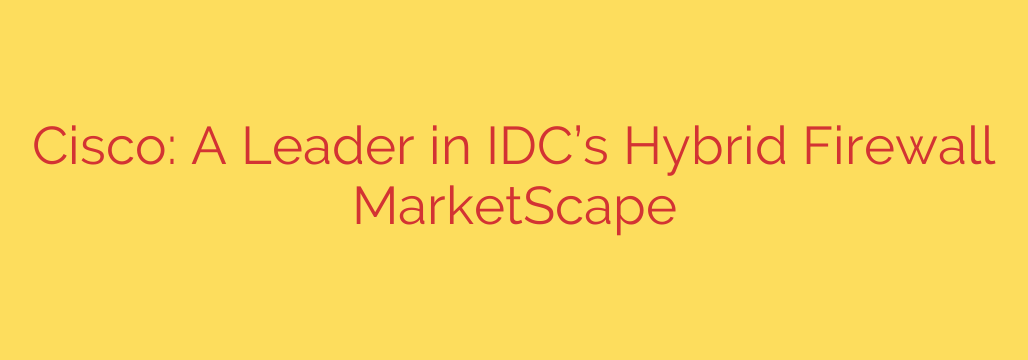
Navigating the New Era of Security: Why the Hybrid Firewall is Essential
The way we work has fundamentally changed. The traditional office-centric model, with its well-defined network perimeter, is a relic of the past. Today, businesses operate in a complex hybrid world where users, data, and applications are distributed across corporate headquarters, branch offices, homes, and multiple cloud environments. This new reality demands a new approach to security.
In this landscape, the traditional security perimeter has dissolved, replaced by a vast, interconnected digital ecosystem. Protecting this ecosystem requires a security solution that is as flexible and distributed as the workforce itself. This is where the hybrid firewall emerges not just as an option, but as a critical necessity for modern enterprises.
What Exactly is a Hybrid Firewall?
A hybrid firewall isn’t a single product but a comprehensive security strategy. It represents the seamless integration of physical, virtual, and cloud-based security controls into a single, cohesive architecture.
At its core, a hybrid firewall approach combines:
- On-Premises Firewalls: Traditional hardware or virtual appliances that protect the corporate network, data centers, and branch offices.
- Cloud-Delivered Firewalls: Security services delivered from the cloud, often as part of a Security Service Edge (SSE) or Secure Access Service Edge (SASE) framework, to protect remote users and cloud applications.
The goal is to provide consistent security policy enforcement and threat protection for all users and devices, regardless of their location. Whether an employee is accessing a cloud application from a coffee shop or a server in the corporate data center, they are protected by the same high standard of security.
The Strategic Advantages of a Hybrid Firewall Model
Adopting a hybrid firewall strategy provides significant benefits that address the core challenges of securing a distributed environment.
1. Consistent Security Everywhere
The primary advantage is uniform protection. A hybrid model allows you to create and enforce a single security policy that applies across your entire infrastructure—from the data center to the cloud to the individual remote user. This eliminates security gaps and ensures that all traffic is inspected against the same threat intelligence and access rules, dramatically reducing complexity and the risk of misconfigurations.
2. Unmatched Scalability and Flexibility
As your business evolves, your security must be able to adapt. A hybrid approach provides the agility needed to scale security up or down based on demand. Migrating more workloads to the cloud? A cloud-native firewall can be deployed instantly. Opening a new branch office? A physical appliance can be managed from the same central console. This flexibility ensures your security posture evolves with your business needs without requiring a complete architectural overhaul.
3. Simplified and Centralized Management
Managing a disparate collection of security tools is a significant challenge for IT teams. Leading hybrid firewall solutions offer a “single pane of glass” management console that provides visibility and control over the entire security estate. This centralized management allows security teams to deploy policies, monitor threats, and respond to incidents efficiently, freeing up valuable time and resources.
4. Superior Threat Protection
Effective security relies on powerful threat intelligence. A robust hybrid firewall is backed by a world-class threat intelligence organization that constantly analyzes global threat data to identify and block emerging attacks. By integrating this intelligence across both on-premises and cloud-based controls, you ensure proactive protection against malware, ransomware, and other sophisticated threats before they can impact your organization.
Key Features to Look for in a Hybrid Firewall Solution
When evaluating solutions to secure your hybrid environment, focus on vendors that offer a complete and integrated platform. Look for these essential capabilities:
- A Unified Management Platform: The ability to manage physical appliances, virtual firewalls, and cloud-native security services from one interface is non-negotiable.
- A Comprehensive Security Portfolio: The solution should include a range of form factors—from high-performance hardware for data centers to lightweight cloud-native options—to meet diverse deployment needs.
- Deep Integration with SASE: The firewall is a foundational component of a SASE architecture. Ensure the solution integrates seamlessly with other security services like Secure Web Gateway (SWG), Cloud Access Security Broker (CASB), and Zero Trust Network Access (ZTNA).
- World-Class Threat Intelligence: Verify that the platform is powered by a dedicated threat research team that provides continuous updates and proactive threat blocking.
Securing Your Hybrid Future
The shift to hybrid work is permanent, and your security strategy must reflect this new reality. Relying solely on traditional, on-premises firewalls is no longer a viable option. It creates security blind spots, increases complexity, and leaves your organization vulnerable to attack.
By embracing a hybrid firewall strategy, you can build a resilient and agile security architecture that protects your users, data, and applications everywhere. This unified approach not only strengthens your security posture but also simplifies operations, enabling your business to innovate and grow with confidence in a complex digital world.
Source: https://feedpress.me/link/23532/17119585/cisco-named-leader-in-idc-marketscape-hybrid-firewall-vendor-assessment








